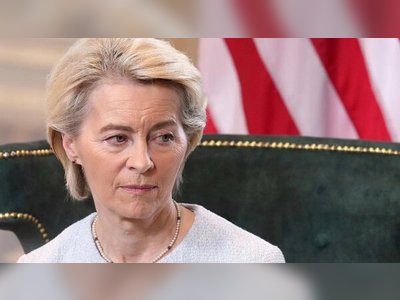
Conservation Efforts in Saudi Arabia Aim to Rescue Dugongs from Extinction
Saudi Arabia's initiatives to protect the endangered dugong species reflect a commitment to preserving marine ecosystems.
Riyadh, Saudi Arabia: The dugong, a shy and slow-moving marine mammal often mistaken for mermaids by early sailors, faces an imminent threat of extinction.
Conservationists are sounding the alarm that without strong protective measures, these elusive creatures may vanish like their closest relative, Steller's sea cow, which became extinct in the 18th century due to relentless hunting.
However, along the Red Sea and Arabian Gulf coastlines of Saudi Arabia, dugongs are finding safe havens as the Kingdom takes deliberate steps to preserve their natural habitat.
The seagrass meadows that dot these coastlines serve as crucial grazing grounds for the dugongs, with conservation efforts focused on safeguarding this vital ecosystem.
The importance of the dugong's presence is underscored by Mirey Atallah, head of the Climate for Nature Branch at the UN Environment Programme.
She points out that the existence or absence of dugongs within an area reflects broader environmental health indicators such as biodiversity and pollution levels.
Dugongs are unique in their dietary habits, feeding exclusively on seagrass in shallow waters.
Despite their gentle demeanor, they reproduce slowly, with females giving birth only once every three to seven years and calves staying close to their mothers for up to two years.
Saudi Arabia is a leader in the global effort to protect dugongs.
The National Center for Wildlife employs satellite tracking and long-term studies to monitor dugong movements.
Public awareness campaigns were launched during Environment Week this year, aiming to educate the public on the importance of these marine creatures to their ecosystems.
The developer behind regenerative tourism projects Red Sea Global (RSG) has also integrated dugong protection into its environmental commitments.
RSG views dugongs as ecologically distinctive species with no regional substitutes and is actively studying foraging grounds and migratory patterns using advanced technologies such as drones and machine learning algorithms.
The area is believed to have the potential to become a regional stronghold for dugongs due to extensive seagrass beds.
The Kingdom's coastlines are significant sanctuaries for the global dugong population, with the Red Sea providing essential feeding grounds and the Arabian Gulf being home to approximately 7,000 animals.
Strict legislation has been put in place by Saudi authorities to penalize any hunting or harming of dugongs, with fines reaching up to SR1 million ($266,465).
Beyond national efforts, Saudi Arabia signed an international agreement in Abu Dhabi in 2013 focused on the protection of dugongs and their habitats.
The National Center for Wildlife represented Saudi Arabia at the first Arab scientific workshop on seagrass conservation, highlighting regional monitoring efforts and promoting global collaboration.
By combining scientific research, legislation, and education, Saudi Arabia aims to ensure that dugongs do not share the fate of their extinct relatives.
Protecting these gentle marine grazers not only secures the species but also helps preserve the delicate ecosystems they inhabit.
Conservationists are sounding the alarm that without strong protective measures, these elusive creatures may vanish like their closest relative, Steller's sea cow, which became extinct in the 18th century due to relentless hunting.
However, along the Red Sea and Arabian Gulf coastlines of Saudi Arabia, dugongs are finding safe havens as the Kingdom takes deliberate steps to preserve their natural habitat.
The seagrass meadows that dot these coastlines serve as crucial grazing grounds for the dugongs, with conservation efforts focused on safeguarding this vital ecosystem.
The importance of the dugong's presence is underscored by Mirey Atallah, head of the Climate for Nature Branch at the UN Environment Programme.
She points out that the existence or absence of dugongs within an area reflects broader environmental health indicators such as biodiversity and pollution levels.
Dugongs are unique in their dietary habits, feeding exclusively on seagrass in shallow waters.
Despite their gentle demeanor, they reproduce slowly, with females giving birth only once every three to seven years and calves staying close to their mothers for up to two years.
Saudi Arabia is a leader in the global effort to protect dugongs.
The National Center for Wildlife employs satellite tracking and long-term studies to monitor dugong movements.
Public awareness campaigns were launched during Environment Week this year, aiming to educate the public on the importance of these marine creatures to their ecosystems.
The developer behind regenerative tourism projects Red Sea Global (RSG) has also integrated dugong protection into its environmental commitments.
RSG views dugongs as ecologically distinctive species with no regional substitutes and is actively studying foraging grounds and migratory patterns using advanced technologies such as drones and machine learning algorithms.
The area is believed to have the potential to become a regional stronghold for dugongs due to extensive seagrass beds.
The Kingdom's coastlines are significant sanctuaries for the global dugong population, with the Red Sea providing essential feeding grounds and the Arabian Gulf being home to approximately 7,000 animals.
Strict legislation has been put in place by Saudi authorities to penalize any hunting or harming of dugongs, with fines reaching up to SR1 million ($266,465).
Beyond national efforts, Saudi Arabia signed an international agreement in Abu Dhabi in 2013 focused on the protection of dugongs and their habitats.
The National Center for Wildlife represented Saudi Arabia at the first Arab scientific workshop on seagrass conservation, highlighting regional monitoring efforts and promoting global collaboration.
By combining scientific research, legislation, and education, Saudi Arabia aims to ensure that dugongs do not share the fate of their extinct relatives.
Protecting these gentle marine grazers not only secures the species but also helps preserve the delicate ecosystems they inhabit.










